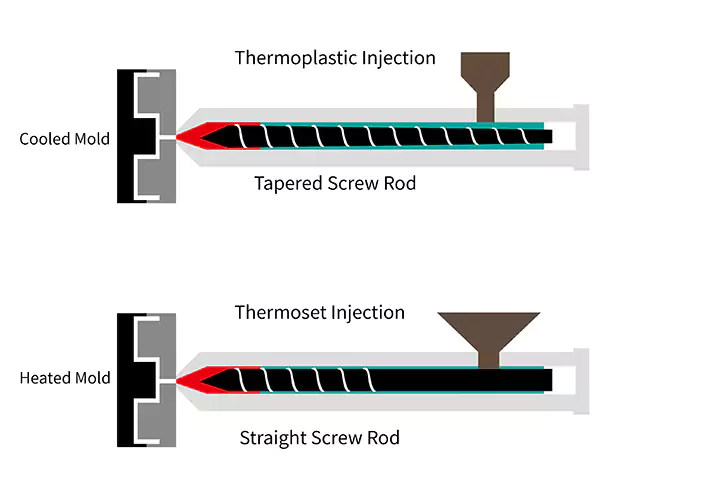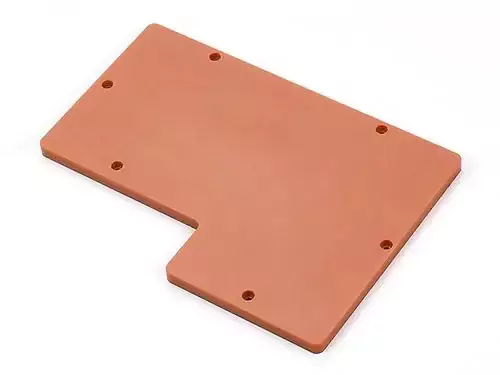Thermoset Plastic vs Thermoplastic: How to Make and Where to Use
Introduction—Thermoset vs Thermoplastic
The key distinction between thermoset plastics and thermoplastics lies in their behavior when heated. When you heat thermoset materials, they get stronger, but you can’t change their shape or heat them again after the first time. On the other hand, thermoplastics can be heated, reshaped, and cooled repeatedly without any chemical changes.
Because of these physical and chemical properties, thermoplastics usually have lower melting points than thermoset plastics, while thermosets can withstand higher temperatures without losing their shape. This article will talk about how each of these thermosetting polymers can be used and what their advantages and disadvantages are.
What are Thermoset Plastics?
Plastics are ubiquitous in the modern world, used in everything from pens to the International Space Station. Despite their simplicity, plastics can withstand harsh physical and chemical conditions such as high heat and corrosion. The secret lies in the use of thermoset plastics, which differ significantly from traditional thermoplastics. Thermosets undergo an initial heat treatment, which sets their physical and chemical properties and makes them impervious to further heat exposure.
This process is akin to hard-boiling an egg, after which reheating does not affect the egg’s shape. Similarly, once a thermoset part has been formed, it is no longer subject to disfigurement due to additional heat exposure. Thermosets’ unique resistance to heat, corrosion, and mechanical creep makes them ideal for components that require high strength-to-weight ratios and tight tolerances, even in elevated temperature environments.
Applications of Thermosetting Plastics
The most common thermosetting plastic is Bakelite. This material is widely used in the housing of electrical appliances and connectors and is also used to make bowls, dishes, and other kitchen utensils.

Thermoset plastics provide an exceptional combination of thermal stability, chemical resistance, and structural integrity, resulting in superior high-performance properties. These properties make them widely used in various industries such as automotive, appliance, electrical, lighting, and energy markets. With excellent chemical and thermal stability, along with superior strength, hardness, and moldability, thermoset components are ideal for these applications.
Furthermore, thermoset plastic composites can meet the requirements of a broad range of production materials at a low cost. Their use enables the fabrication of both small and large parts with high production volume while maintaining repeatability consistently from batch to batch. Thermosets offer an alternative process when metal fabrication or the use of thermoplastics cannot achieve complex and geometric shapes but can be manufactured in a mold.
Thermoset plastics are stable in all environments and temperatures, providing reliable performance under various conditions.
Thermosets Molding process

Like rubber molding, the most common molding processes of thermosetting plastics are compression molding and transfer molding. Injection molding can also be used, but on a very different machine than for thermoplastics. The mold of thermoplastic injection molding machine needs to be cooled. The diameters of the front and rear ends of the screw are different. As the material is conveyed to the mold, it will be gradually extruded to generate heat to melt the plastic. The mold of the thermosetting plastic injection molding machine needs to be heated, and the diameter of the front and rear ends of the screw is the same.
Advantages of Thermosets

Thermoset plastics offer several advantages over thermoplastics. Unlike thermoplastics, thermosets maintain their strength and shape even when exposed to heat, making them ideal for producing permanent components and large, solid shapes. Furthermore, these components possess excellent strength characteristics (albeit with some brittleness) and can withstand higher operating temperatures without significant strength loss.
As a result, manufacturers have increasingly turned to the use of thermoset plastics as a more cost-effective replacement for metal components.
The benefits that thermoset plastics can offer over their metal counterparts include:
Available molded-in tolerances
Choice of color and surface finishes
High strength-to-weight ratio and performance
Outstanding dielectric strength
Low thermal conductivity and microwave transparency
Resistance to corrosion effects and water
Lower tooling/set-up costs
Reduced production costs over fabrication using metals
Disadvantages of Thermosets
While thermosets offer some advantages, there are also some drawbacks to their use. The material properties of thermosets are generally not as advanced as those of thermoplastics, which can lead to issues such as low tensile strength and ductility. As a result, parts made from thermosets may require thick walls to compensate.
The low initial viscosity of thermoset materials can result in flash and the need for secondary operations, while the use of reactive compounds can impact the material’s shelf life. Batch processes may also exhibit greater variation and less consistency from lot to lot.
Furthermore, high levels of filler in thermoset materials may result in excessive tool wear, and the quality of the final product is dependent on the degree of crosslinking established during the molding cycle. Overall, while thermosets offer some benefits, they are not without their limitations and drawbacks.
What are Thermoplastics?
As previously mentioned, plastics are widely utilized in various applications and are a real-world manifestation of the utilization of chemistry. From medical devices that save lives to aerospace components, plastic is a versatile material that is ubiquitous in our lives. Among the types of plastics available, thermoplastic polymers are notable for their versatility and recyclability. These polymers are formed when repeating units or monomers link together to create chains or branches.
When heated, thermoplastic pellets become more fluid and can be molded easily. The curing process is entirely reversible as no chemical bonding takes place. This feature allows for the remolding and recycling of thermoplastics without affecting the material’s physical properties. There are various thermoplastic resins available, with each offering different performance benefits, but the most commonly used materials provide high strength, shrink resistance, and flexibility. Depending on the resin, thermoplastics can be utilized in low-stress applications such as plastic bags or high-stress mechanical components. Examples of thermoplastic polymers include polyethylene, PVC, and nylon.
Applications of Thermoplastics
Steel piping systems in modern cities are at risk of rust and corrosion due to pollution and acidic environments. Protecting these systems from corrosion can be costly. As a cost-effective solution, thermoplastics are considered a favorable substitute. Thermoplastics offer several properties that make them suitable for this purpose:
Resistance to corrosive materials and environments.
Ability to handle extreme temperatures of hot or cold materials.
Versatility in handling various fluid transport applications.
Materials commonly used to produce these pipes are PVC or CPVC, but polypropylene, PVDF, ABS, nylon, and polyethylene are also used. For example, polyethylene gas tanks are used to transport natural gas for residential and commercial applications.
In addition, thermoplastics have a wide range of applications. High-pressure polyethylene is used to encapsulate rigid objects like electrical equipment, while low-pressure polyethylene is elastic and ideal for insulating electrical cables. Polyamide is commonly used in the production of ropes and belts.
Thermoplastics Molding process
The most popular thermoplastics molding process is injection molding. Although theoretically thermoplastics can be melted multi-times, they can be injected multiple times, but the physical properties of multiple injection molded plastics will become brittle and easy to break. Therefore, there are generally restrictions on the proportion of recycled plastics that can be added to injection molding products.
Advantages and Disadvantages of Thermoplastics
Advantages of Thermoplastics
Versatility
Thermoplastics can be molded into various shapes and sizes, making them suitable for a wide range of applications.
Recycling
Thermoplastics can be recycled, reducing the amount of waste and environmental impact.
Cost-effective
Compared to other materials, thermoplastics are relatively inexpensive, making them a cost-effective solution for many applications.
Chemical Resistance
Thermoplastics are resistant to chemical reactions, making them ideal for use in chemical processing industries.
Durability
Thermoplastics are durable, with excellent impact resistance, and can withstand harsh environments.
Disadvantages of Thermoplastics
Limited Heat Resistance
While thermoplastics can handle hot and cold temperatures, they have limited heat resistance compared to other materials.
Low-Temperature Resistance
Some thermoplastics become brittle in extremely low temperatures, reducing their usefulness in certain applications.
Limited Strength
Thermoplastics have limited strength compared to metals and ceramics, limiting their use in certain applications.
Flammability
Some thermoplastics are flammable, which can be a safety concern in certain applications.
Limited UV Stability
Some thermoplastics are prone to UV degradation, making them unsuitable for outdoor applications without additional UV stabilizers.
Difference Between Thermoplastics and Thermosets
The difference between thermoplastics and thermosets lies in how they behave during the curing process. Thermosets become stronger but form chemical bonds that make them impossible to remold, while thermoplastics do not form any chemical bond and are therefore re-mouldable and recyclable. The three-dimensional bonding in thermosets makes them stronger and more heat-resistant than thermoplastics.
Thermosets’ ability to maintain their strength and geometry at high temperatures sets them apart from thermoplastics, which often degrade before melting when exposed to excessive heat. This property makes plastics a cost-effective replacement for metals in certain applications.
In summary, thermosets generally exhibit superior physical properties compared to thermoplastics, but they cannot be remolded or recycled.
Conclusion
In conclusion, thermoset and thermoplastic materials offer unique advantages and disadvantages depending on the intended application. Thermosets offer exceptional strength, durability, and heat resistance but cannot be remolded or recycled. Thermoplastics, on the other hand, offer versatility, cost-effectiveness, and recyclability, but have limited heat resistance and strength compared to thermosets. Understanding the properties and behavior of both materials is crucial in selecting the appropriate material for a particular application.